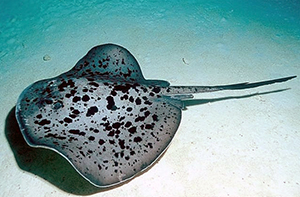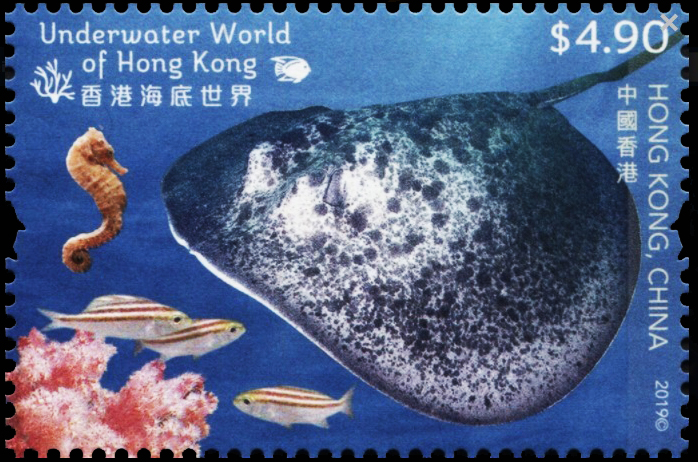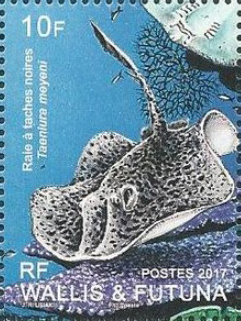Taeniurops meyeni J. P. Müller & Henle, 1841

Phylum: Chordata Haeckel, 1874
Subphylum: Vertebrata Lamarck J-B., 1801
Classe: Chondrichthyes Huxley, 1880
Ordine: Myliobatiformes Compagno, 1973
Famiglia: Dasyatidae Jordan D.S., 1888
Genere: Taeniura Müller and Henle, 1837
Italiano: Pastinaca a macchie nere
English: Round ribbontail ray
Français: Raie à taches noires
Descrizione
Gli adulti possono raggiungere i 300 cm di lunghezza ed i 150 kg di peso. Il corpo, di tipica forma discoidale, è molto robusto; gli occhi, piccoli e sommitali, sono seguiti da evidenti spiracoli. Presso la base della coda sono presenti uno o più aculei veleniferi, aventi uno scopo esclusivamente difensivo. Il dorso è di colore grigio scuro, ornato da numerose chiazze nere (da qui il nome comune). Il ventre è bianco. Si nutre di piccoli pesci bentonici, crostacei e molluschi, che cattura frugando con forza nella sabbia. È una specie ovovivipara.
Diffusione
distribuita nelle acque tropicali del Mar Rosso, dell'Oceano Indiano e dell'Oceano Pacifico. È piuttosto comune sui fondali sabbiosi dai 20 metri di profondità in poi.
Sinonimi
= Taeniura melanospila Bleeker, 1853 = Taeniura mortoni Macleay, 1883.
Bibliografia
–Kyne, P.M. & W.T. White (2006). "Taeniura meyeni". IUCN Red List of Threatened Species. 2006. Retrieved February 25, 2010.
–Eschmeyer, W.N., ed. Catalog of Fishes electronic version (February 19, 2010) Archived August 24, 2012, at the Wayback Machine. Retrieved on February 25, 2010.
–Bester, C. Biological Profiles: Blotched Fantail Ray. Florida Museum of Natural History Ichthyology Department. Retrieved on February 25, 2010.
–Froese, Rainer and Pauly, Daniel, eds. (2010). "Taeniura meyeni" in FishBase. February 2010 version.
–Bull ray, stingray spines Archived 2006-08-21 at the Wayback Machine. Julian Rocks. Retrieved on February 25, 2010.
–Lovejoy, N.R. (1996). "Systematics of myliobatoid elasmobranchs: with emphasis on the phylogeny and historical biogeography of neotropical freshwater stingrays (Potamotrygonidae: Rajiformes)" (PDF). Zoological Journal of the Linnean Society. 117 (3): 207-257.
–Last, P.R. & J.D. Stevens (2009). Sharks and Rays of Australia (second ed.). Harvard University Press. pp. 460-461.
–Smith, J.L.B.; M.M. Smith & P.C. Heemstra (2003). Smiths' Sea Fishes. Struik. p. 141.
–Grove, J.S. & R.J. Lavenberg (1997). The Fishes of the Galápagos Islands. Stanford University Press. pp. 119-121.
–Ferrari, A. & Ferrari, A. (2002). Sharks. FireFly Books. pp. 212-213.
–Michael, S.W. (1993). Reef Sharks & Rays of the World. Sea Challengers. p. 89.
–Hennemann, R.M. (2001). Sharks & Rays: Elasmobranch Guide of the World (second ed.). IKAN - Unterwasserarchiv. pp. 256-259.
–Timofeeva, T.A. (1983). "New representatives of monocotylids (Monogenea: Monocotylidae) from cartilaginous fishes of the South China and Yellow Seas". Trudy Zoologicheskogo Instituta. 121: 35-47.
–Chisholm, L.A. & I.D. Whittington (March 2004). "Two new species of Dendromonocotyle Hargis, 1955 (Monogenea : Monocotylidae) from the skin of Taeniura meyeni (Dasyatidae) and Aetobatus narinari (Myliobatidae) from aquaria in Queensland, Australia". Systematic Parasitology. 57 (3): 221-228.
–Whittington, I.D. & G.C. Kearn (2009). "Two new species of entobdelline skin parasites (Monogenea, Capsalidae) from the blotched fantail ray, Taeniura meyeni, in the Pacific Ocean, with comments on spermatophores and the male copulatory apparatus" (PDF). Acta Parasitologica. 54 (1): 12-21.

|
Data: 16/07/2019
Emissione: Il mondo sottomarino di Hong Kong Stato: China (Hong Kong) Nota: Emesso in un foglietto di 6 v. diversi |
|---|

|
Data: 22/09/2017
Emissione: Ittiofauna - Razze Stato: Wallis and Futuna Nota: Emesso in un foglietto di 4 v. diversi |
|---|